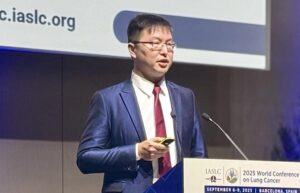In the past decade, targeting of the PD-1/PD-L1 checkpoint, with or without CTLA-4 targeting, has revolutionized cancer treatment. However, a significant proportion of patients with lung cancer still do not benefit from these advances. In the patients who benefit most, the expression of PD-L1 in the tumor is, in general, high.1
An effective immune response requires the presence of non-terminally exhausted tumor-directed T-cells; after the brake of the PD-1/PD-L1 has been released, these T-cells are then able to target the tumor and to proliferate, inducing a long-lasting tumor response.2
A higher PD-L1 expression is predictive for this activation. However, it is now known that this induction of T-cells is not occurring in a significant proportion of patients after targeting of PD-1/PD-L1.2
Various novel treatment combinations are still under study, but a clinically significant improvement in outcome has been observed when PD-1/PD-L1 checkpoint inhibition was combined with chemotherapy.3
This is now the standard of care in the absence of genetic-aberration targeting therapies.4
Chemotherapy appears to have an additive effect to the individual treatments of PD-1 or PD-L1 and chemotherapy; this is called the immunogenic effect of the chemotherapy.5
Although much is still to be learned, the general concept is that chemotherapy-induced death of tumor cells activates intratumoral dendritic cells. Dendritic cells are the most potent antigen-presenting cells in our body. These cells activate both the innate and the adaptive immune responses. The dendritic cells continuously search the surroundings for foreign antigens. When these antigens are taken up by the dendritic cells, the latter migrate to the lymph nodes, where they present the antigens to immature T-cells. These immature T-cells mature into tumor-directed T-cells and evade the lymph nodes, then migrate to and infiltrate the tumor. The importance of these dendritic cells in lung cancer has been shown in multiple studies.2
,6
However, the immunosuppressive environment induced by the tumor also causes inactivation of dendritic cells and consequently may prevent the antigen presentation in the lymph node. Furthermore, the damage caused by chemotherapy may lead to activation and influx of dendritic cells—this damage consists of not only the previously mentioned tumor cell death but also the inflammation caused by this cell death. Inflammation is a known catalyzer for immune activation. Apart from that, recent studies have also shown that chemotherapy induces a reduction in immunosuppressive cells. Depending on the specific chemotherapeutic agent used, different mechanisms have been described.2
All of these may lead to more activation of the dendritic cells, inducing an effective T-cell response.
The potency of dendritic cells as regulators of the immune activation has also gained therapeutic interest. Various studies on dendric cell treatment have been performed and are ongoing.7
,8
Dendritic cells can be cultured relatively easily from peripheral blood and loaded with an antigen of choice, like mRNA, viral constructs, or lysates. For instance, autologous dendritic cells transfected with an adenoviral construct have been injected intratumorally into patients with lung cancer.9
Or, as we are investigating, autologous dendritic cells can be loaded with a tumor cell lysate derived from cellines.10
In addition, the concept of combination treatment of checkpoint inhibition and dendritic cell therapy is being explored.11
In recent years we have seen the potential of immunotherapy in cancer treatment and increased our understanding of the interaction between the tumor and the immune system. There is still much to be explored, however. The potential therapeutic benefits of dendritic cells in lung cancer treatment makes this a field well-worth further investigation.
- 1. Mok TSK, Wu YL, Kudaba I, et al; KEYNOTE-042 Investigators. Pembrolizumab versus chemotherapy for previously untreated, PD-L1-expressing, locally advanced or metastatic non-small-cell lung cancer (KEYNOTE-042): a randomised, open-label, controlled, phase 3 trial. Lancet. 2019;393(10183):1819-1830.
- 2. a. b. c. d. Dammeijer F, van Gulijk M, Mulder EE, et al. The PD-1/PD-L1-Checkpoint Restrains T cell Immunity in Tumor-Draining Lymph Nodes. Cancer Cell. 2020;38(5):685-700.
- 3. Gandhi L, Rodríguez-Abreu D, Gadgeel S, et al; KEYNOTE-189 Investigators. Pembrolizumab plus Chemotherapy in Metastatic Non-Small-Cell Lung Cancer. N Engl J Med. 2018;378(22):2078-2092.
- 4. Planchard D, Popat S, Kerr K, et al.; ESMO Guidelines Committee. Metastatic non-small cell lung cancer: ESMO Clinical Practice Guidelines for diagnosis, treatment and follow-up. Ann Oncol. 2018;29(suppl 4):iv192-iv237.
- 5. Dammeijer F, De Gooijer CJ, van Gulijk M, et al. Immune monitoring in mesothelioma patients identifies novel immune-modulatory functions of gemcitabine associating with clinical response. EBioMedicine. 2021;64:103160.
- 6. Zhao W, Zhu B, Hutchinson A, et al. Clinical Implications of Inter- and Intra-Tumor Heterogeneity of Immune Cell Markers in Lung Cancer. J Natl Cancer Inst. 2021.
- 7. Stevens D, Ingels J, Van Lint S, Vandekerckhove B, Vermaelen K. Dendritic Cell-Based Immunotherapy in Lung Cancer. Front Immunol. 2021;11:620374.
- 8. Belderbos RA, Vroman H, Aerts JGJV. Cellular Immunotherapy and Locoregional Administration of CAR T-Cells in Malignant Pleural Mesothelioma. Front Oncol. 20209;10:777.
- 9. Lee JM, Lee MH, Garon E, et al. Phase I Trial of Intratumoral Injection of CCL21 Gene-Modified Dendritic Cells in Lung Cancer Elicits Tumor-Specific Immune Responses and CD8(+) T-cell Infiltration. Clin Cancer Res. 2017;23(16):4556-4568.
- 10. Aerts JGJV, de Goeje PL, Cornelissen R, et al. Autologous Dendritic Cells Pulsed with Allogeneic Tumor Cell Lysate in Mesothelioma: From Mouse to Human. Clin Cancer Res. 2018;24(4):766-776.
- 11. Lau SP, van Montfoort N, Kinderman P, et al. Dendritic cell vaccination and CD40-agonist combination therapy licenses T cell-dependent antitumor immunity in a pancreatic carcinoma murine model. J Immunother Cancer. 2020;8(2):e000772.










